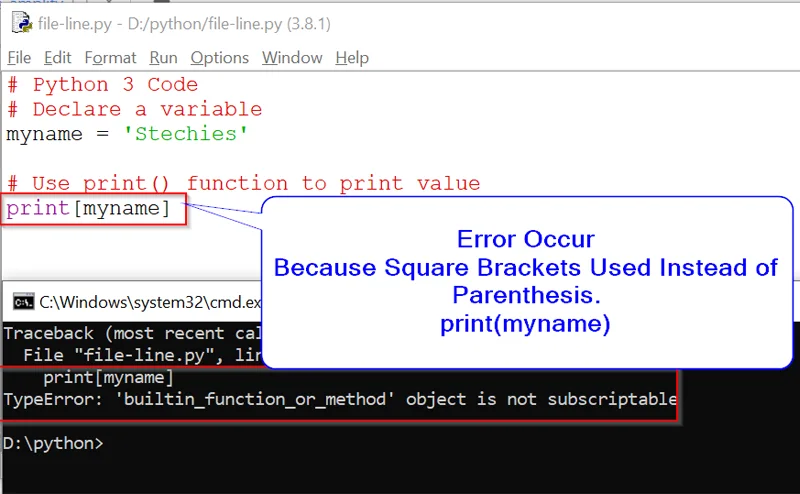Typeerror ‘Builtin_Function_Or_Method’ Object Is Not Subscriptable
When working with Python, you may encounter an error message like “TypeError: ‘builtin_function_or_method’ object is not subscriptable.” This error typically occurs when you try to access or modify an element of an object that does not support indexing or slicing. In this article, we will explore the possible causes of this error and provide solutions to fix it.
Possible Causes of the TypeError ‘builtin_function_or_method’ object is not subscriptable:
1. Attempting to access elements of a non-indexable object:
One common cause of this error is when you try to access elements of an object that does not support indexing. For example, if you try to access an element of a built-in function or method, you will encounter this error. Built-in functions and methods are not iterable like lists or strings, so you cannot access their elements using indexing.
2. Confusion between accessing attributes and invoking a method:
Another cause of this error is confusion between accessing attributes and invoking a method. If you mistakenly try to use square brackets to access an attribute of an object, you will encounter this error. Remember, attributes are accessed using dot notation, while methods are invoked using parentheses.
3. Forgetting to include parentheses when calling a method:
This error can also occur if you forget to include parentheses when calling a method. In Python, parentheses are required to invoke a method. If you mistakenly try to access a method as an attribute without calling it, you will encounter this error.
4. Trying to access or modify the arguments of a built-in function or method:
Built-in functions and methods have predefined arguments, and you cannot directly access or modify them using indexing. If you try to access or modify the arguments of a built-in function or method, you will encounter this error.
5. Incorrect usage of indexing or slicing on a non-indexable object:
This error can also occur if you incorrectly use indexing or slicing on an object that does not support these operations. For example, if you try to slice a built-in function or method, you will encounter this error.
6. Errors related to using functions or methods on objects of the wrong data type:
Python is a dynamically-typed language, which means that the data type of an object can change at runtime. This error can occur if you try to use functions or methods on objects of the wrong data type. For example, if you try to access an element of an integer object using indexing, you will encounter this error.
7. Issues caused by outdated or incompatible Python versions:
Sometimes, this error can be caused by outdated or incompatible Python versions. If you are using an outdated version of Python, certain features or functionalities may not be supported, resulting in this error. Make sure you are using a compatible and up-to-date version of Python.
Solutions to fix the TypeError ‘builtin_function_or_method’ object is not subscriptable:
1. Check if the object is indexable:
Before trying to access or modify an element of an object, check if the object supports indexing or slicing. If it doesn’t, consider using alternative methods or data structures to achieve your desired outcome.
2. Verify the correct usage of attributes and methods:
Double-check if you are accessing attributes using dot notation and invoking methods using parentheses. Avoid confusing attributes and methods, as they have different syntax and behavior.
3. Ensure proper method invocation:
Make sure that you include parentheses when calling a method. Without parentheses, you are treating the method as an attribute, which can lead to this error.
4. Avoid accessing or modifying the arguments of built-in functions or methods:
Built-in functions and methods have predefined arguments, and you cannot directly access or modify them using indexing. If you need to modify the behavior of a built-in function or method, consider creating a custom function or method instead.
5. Check for correct usage of indexing or slicing:
If you are using indexing or slicing, ensure that you are applying it to objects that support these operations. Built-in functions and methods are not iterable, so they do not support indexing or slicing.
6. Verify the data type of the object:
Ensure that you are using functions or methods on objects of the correct data type. If you encounter this error, double-check the data type of the object and make sure it supports the operations you are trying to perform.
7. Update Python to a compatible version:
If you suspect that the error is caused by an outdated or incompatible Python version, consider updating to a compatible version. Check the documentation or consult the Python community for guidance on compatible versions.
In conclusion, the TypeError ‘builtin_function_or_method’ object is not subscriptable typically occurs when trying to access elements of an object that does not support indexing or slicing. This article covered the possible causes of this error and provided solutions to fix it. By understanding these causes and solutions, you can effectively troubleshoot and resolve this error in your Python code.
FAQs:
Q: What does the error message “TypeError: ‘builtin_function_or_method’ object is not subscriptable” mean?
A: This error message indicates that you are trying to access or modify an element of an object that does not support indexing or slicing.
Q: How can I fix the TypeError ‘builtin_function_or_method’ object is not subscriptable?
A: To fix this error, you can check if the object is indexable, ensure correct usage of attributes and methods, include parentheses when calling a method, avoid accessing or modifying the arguments of built-in functions or methods, use indexing or slicing correctly, verify the data type of the object, and update Python to a compatible version if necessary.
Q: Can this error be caused by outdated Python versions?
A: Yes, sometimes this error can be caused by outdated or incompatible Python versions. Make sure you are using a compatible and up-to-date version of Python to avoid such issues.
How To Fix Object Is Not Subscriptable In Python
What Does Builtin_Function_Or_Method Object Is Not Subscriptable Mean In Python?
If you have been using Python for a while, you may have encountered the error message “builtin_function_or_method object is not subscriptable.” This error often perplexes beginners and even some experienced programmers. But fear not! In this article, we will explain what this error means, explore the possible reasons behind it, and provide solutions to fix it.
Understanding the Error Message:
———————————
Before diving into the details, let’s break down the error message itself. “builtin_function_or_method” refers to a built-in function or method in Python. This error typically occurs when you try to access the elements of an object that is not a data structure, such as a function or a method. The term “subscriptable” means that an object can be accessed using square brackets [ ] to retrieve its elements.
Possible Causes of the Error:
——————————
1. Forgetting Parentheses:
One common mistake that leads to this error is forgetting to include parentheses after a function or method call. In Python, if you omit the parentheses, the function or method itself is returned rather than its result. Therefore, attempting to subscript the function or method directly will raise the “builtin_function_or_method object is not subscriptable” error.
2. Misusing Built-in Functions:
Another cause of this error is misusing built-in functions. Certain built-in functions, such as len() or type(), do not return objects that can be subscripted. For example, calling len(some_variable)[0] to access the first element will raise this error because the len() function returns an integer, not a collection of elements.
3. Incorrect Variable Assignment:
If you mistakenly assign a function or method to a variable, and then attempt to subscript that variable, you will encounter this error. Remember to assign function calls without including the parentheses to store the function itself, not its result.
4. Using Non-subscriptable Objects:
It’s important to understand that not all objects in Python are subscriptable. For instance, numbers, strings, and Boolean values are not subscriptable. Thus, if you try to access their elements using square brackets, you will encounter this error.
Solutions to Fix the Error:
—————————
1. Check Parentheses:
If you have forgotten to include parentheses after a function or method call, simply add them. This will execute the function or method, returning the appropriate result that can be subscripted if applicable.
2. Utilize the Built-in Function as Intended:
Ensure that you are using the correct approach when using built-in functions. For example, if you want to access the first element of a string, use string_name[0] instead of len(string_name)[0]. This way, you are directly subscripting the string itself.
3. Validate Variable Assignments:
Double-check variable assignments to make sure that you are storing functions or methods when intended. Avoid including parentheses when assigning so that you do not store the result instead.
4. Avoid Subscripting Non-subscriptable Objects:
Remember that certain objects, like numbers or strings, cannot be subscripted directly. If you need to access a specific element, make sure to convert the object into a subscriptable data structure, such as a list or tuple, before performing the subscript operation.
Frequently Asked Questions (FAQs):
———————————-
Q1: Can you provide an example of a “builtin_function_or_method object is not subscriptable” error?
A: Certainly! Let’s say you have the following code snippet:
my_function = len
print(my_function[0])
Executing this code will raise the “builtin_function_or_method object is not subscriptable” error because you are trying to access the first element of the len() function, which is not subscriptable.
Q2: What should I do if I encounter this error in my code?
A: First, carefully review your code and ensure that you are not trying to subscript a function or method directly. Consider whether you are misusing a built-in function or if you need to convert the object into a subscriptable type before accessing its elements.
Q3: Are all built-in functions or methods not subscriptable?
A: No, only specific built-in functions or methods that do not return subscriptable objects will raise this error. Most built-in functions or methods return objects that can be subscripted, such as strings, lists, dictionaries, or tuples.
In conclusion, encountering the “builtin_function_or_method object is not subscriptable” error in Python indicates that you are attempting to access elements of a non-subscriptable object, such as a function or method. Understanding the causes and solutions discussed in this article will help you overcome this error and write efficient Python code. Remember to pay attention to your variable assignments and utilize built-in functions correctly to avoid this error in your future Python projects.
What Does It Mean If An Object Is Not Subscriptable?
In the world of programming, the term “subscriptable” refers to the ability of an object to be indexed or accessed using square brackets. This means that you can use the object’s index position to retrieve or modify specific elements within the object. However, there are instances where an object is not subscriptable, meaning that it cannot be accessed using this method. In this article, we will dive into the concept of subscriptability, explore why some objects are not subscriptable, and discuss common examples and potential workarounds.
Understanding Subscriptability:
To grasp the concept of subscriptability, it is important to understand how it is used in programming. In many programming languages, square brackets are used to access elements within an object, such as lists, arrays, or dictionaries. For instance, if you have a list with elements [1, 2, 3], you can access the first element using the index 0 like this: list[0]. This makes it possible to perform various operations on the elements within an object.
The subscript notation is particularly useful when working with data structures, as it allows for efficient element retrieval and manipulation. However, not all objects support subscriptability, which can lead to confusion and frustration for programmers.
Why Are Some Objects Not Subscriptable?
There are several reasons why certain objects may not be subscriptable. One common reason is that the object in question doesn’t have a defined order or sequence. For example, a set is an unordered collection of unique elements, so it wouldn’t make sense to access its elements using an index.
Additionally, some objects are immutable, meaning they cannot be changed once created. Immutable types, such as strings, tuples, or numbers, are generally not subscriptable because their elements can’t be modified individually. Instead, you would need to create a new object with the desired changes.
Another reason for lack of subscriptability is that the object’s class does not implement the necessary special methods. These methods, such as __getitem__() and __setitem__(), define how objects should behave when accessed using square brackets. If these methods are not implemented, the object cannot be subscripted.
Common Examples of Non-Subscriptable Objects:
To better understand the concept, let’s examine a few common examples of objects that are not subscriptable:
1. Integer or Float: Numeric types like integers and floats cannot be subscripted because they are immutable. To extract specific digits or decimal places, you would need to convert them into a different data structure, such as a string.
2. NoneType: The NoneType object, which represents the absence of a value, is not subscriptable. It is used to indicate the absence of a return value or an uninitialized variable.
3. Function Objects: In general, functions themselves cannot be accessed using square brackets. However, function objects may provide subscriptability if they have implemented the necessary special methods.
Workarounds for Non-Subscriptable Objects:
Although an object may not be subscriptable by default, there are often alternative methods to access or modify its elements. Here are a few workarounds:
1. Conversion: If you encounter a non-subscriptable object, consider converting it into a different data structure that supports subscripting. For instance, you can convert a string into a list of characters.
2. Methods: Explore the available methods of the object. Many non-subscriptable objects, such as strings, have built-in methods that allow you to extract or modify specific parts of the object.
3. Iteration: If an object cannot be accessed using square brackets, you can iterate over its elements instead. By using loops such as for or while, you can process the elements sequentially.
FAQs:
Q: Why does it matter if an object is subscriptable or not?
A: Subscriptability allows for efficient element access and manipulation within an object. It enables programmers to retrieve specific elements, modify them, or perform other operations on the object.
Q: Can I make a non-subscriptable object subscriptable?
A: In some cases, you can modify or extend the behavior of an object to make it subscriptable. This typically involves implementing the necessary special methods for subscripting.
Q: How can I determine if an object is subscriptable?
A: You can check whether an object is subscriptable by attempting to access its elements using square brackets. If it raises an error or doesn’t provide the expected behavior, the object is likely not subscriptable.
Q: Are there any disadvantages to subscriptability?
A: Subscriptability itself is not inherently disadvantageous. However, it’s important to consider the specific use case and potential performance implications when selecting the appropriate data structure for your task.
In conclusion, subscriptability refers to the ability of an object to be accessed using square brackets. Some objects, such as sets, numbers, or NoneType, are not subscriptable due to their nature, immutability, or lack of necessary methods. When encountering non-subscriptable objects, alternative approaches such as conversion, methods, or iteration can be employed. It’s essential to understand the subscriptability of objects to effectively work with different data structures and write robust code.
Keywords searched by users: typeerror ‘builtin_function_or_method’ object is not subscriptable Builtin_function_or_method’ object does not support item assignment, Builtin_function_or_method’ object is not iterable, Builtin_function_or_method, Object is not subscriptable, Int’ object is not subscriptable, Object is not subscriptable python3, TypeError: ‘type’ object is not subscriptable, TypeError property object is not subscriptable
Categories: Top 97 Typeerror ‘Builtin_Function_Or_Method’ Object Is Not Subscriptable
See more here: nhanvietluanvan.com
Builtin_Function_Or_Method’ Object Does Not Support Item Assignment
Understanding the Error:
To fully grasp the error message, let’s break it down into its components:
– “TypeError”: This indicates that a function or method was expecting a different type of object for a specific operation.
– “‘builtin_function_or_method’ object”: This refers to a built-in function or method in Python, which are predefined and provide functionality for various operations.
– “does not support item assignment”: This means that you are attempting to modify an item within the function or method using item assignment, but this is not allowed since functions and methods are immutable objects.
Immutability in Python:
In Python, immutability is a fundamental concept that states that once an object is created, its state cannot be changed. Immutable objects include numbers, strings, and tuples. On the other hand, mutable objects such as lists and dictionaries can have their elements modified.
Functions and methods, being immutable objects, are not designed to be modified directly. They are meant to be called and executed to perform predefined operations. Therefore, any attempt to assign a value to an item within a function or method will result in the aforementioned error.
Common Causes of the Error:
There are a few common scenarios that can trigger the “builtin_function_or_method” error. Let’s explore them:
1. Incorrect Usage of Functions: This error can occur when trying to assign a value to a function itself, rather than its return value. For example:
“`
# Incorrect usage of function
len = 10
“`
In the above code snippet, the intention might have been to store the length of a value in the variable `len`. However, by using the same name as the built-in `len()` function, we overwrite the function with an integer value, leading to the error when trying to use the function later on.
2. Conflicting Variable Names: Using variable names that clash with built-in function names can also result in this error. If you mistakenly assign a value to a built-in function’s name, attempting to use that function later will trigger the error. For instance:
“`
# Assigning to a built-in function name
print = “Hello, World!”
print(“Hello, AI!”)
“`
Here, the intention was most likely to print the message “Hello, AI!”. However, by assigning a string to the variable name `print`, the built-in `print()` function is overwritten, leading to the error when trying to use it.
Solutions and Workarounds:
Now that we understand the causes of the error, let’s explore some solutions and workarounds.
1. Avoid Assigning to Built-in Functions: It is crucial to refrain from assigning a value to a built-in function or method name. By doing so, you risk encountering the error described in this article. Therefore, double-check your variable names and avoid using names that clash with Python built-in functions.
2. Use Descriptive Variable Names: Using descriptive variable names can help to avoid confusion and unintended assignments. By choosing names that clearly represent the purpose of a variable, you can minimize the chances of inadvertently assigning values to built-in functions.
3. Restart the Python Interpreter: If you accidentally assign a value to a built-in function during the course of your program, one quick solution is to restart the Python interpreter. This will reset all your variables and provide a fresh environment without any potential conflicts.
4. Use Variable Shadowing Carefully: If you intentionally shadow a built-in function with a variable, be cautious while doing so. Make sure you understand the implications and the potential consequences within your code. Minimizing shadowing is generally recommended to avoid confusion and errors.
5. Use Aliases: In cases where the built-in function or method needs to be used alongside a modified version, it is advisable to create an alias using a different name. This way, the original function remains accessible without conflict. For example:
“`
# Alias for len function
length = len
“`
In the above snippet, the `length` variable is assigned the `len` function, allowing it to be called later without any issues.
FAQs:
Q: Can I assign a value to a function or method argument?
A: No, you cannot assign a value directly to a function or method argument. Arguments are essentially placeholders for the values that will be passed in when the function or method is called.
Q: Is it possible to modify the behavior of a built-in function?
A: No, it is not advisable or possible to modify the behavior of a built-in function or method directly. If you need to modify their behavior, you can create your own functions with distinct names.
Q: What should I do if I accidentally assign a value to a built-in function?
A: If you accidentally assign a value to a built-in function, restarting the Python interpreter is the easiest solution. However, it is always better to avoid such situations by using descriptive variable names or creating aliases when necessary.
In conclusion, the “builtin_function_or_method” error occurs when attempting to assign a value to an item within a function or method. This is due to the immutability of functions and methods in Python. By understanding the causes of the error and following the provided solutions and workarounds, you can effectively handle and avoid this error in your Python programs.
Builtin_Function_Or_Method’ Object Is Not Iterable
If you’ve ever come across the error message “‘builtin_function_or_method’ object is not iterable” while coding in Python, you might have found yourself puzzled and unsure about its meaning and how to resolve it. It can be a frustrating error, especially for beginner programmers. In this article, we will dive deep into this error, explain its causes, and offer solutions to help you address it effectively.
What does the error message mean?
The error message itself provides clues about the problem. It indicates that you attempted to iterate over a function or method object in Python that isn’t designed to be iterable. In Python, an iterable is any object capable of returning its members one at a time. It is used in constructs like loops, list comprehensions, and other operations that expect a sequence of values.
Causes of the error:
There are a few common causes that can trigger the “‘builtin_function_or_method’ object is not iterable” error:
1. Forgetting to call the function: This error can occur if you forget to call the function or method using parentheses. For example, if you mistakenly write `my_function` instead of `my_function()`, Python treats it as a reference to the function object itself and not as an invocation.
2. Assigning a function to a variable: Python allows functions to be assigned to variables. However, if you later try to iterate over the variable instead of invoking it, the error will be triggered. Double-check that you’re calling the function correctly or use a different variable name to avoid confusion.
3. Incorrect usage of parentheses: Misplacing or missing parentheses can also lead to this error. For instance, writing `my_function().next()` instead of `my_function.next()` will result in the error message.
Solutions to resolve the error:
1. Check function invocation: Ensure that you are calling the function or method correctly with the appropriate parentheses. This means including the parentheses `()` after the function name to invoke it.
2. Verify variable usage: If you have assigned the function to a variable, ensure that you’re actually calling the variable as a function using the parentheses. Avoid naming your variable the same as the function to prevent confusion and potential errors.
3. Parentheses placement: Be mindful of where you place the parentheses when working with methods or functions that return objects. For example, if you want to call a function within an object, write `object.my_function()` instead of `object.my_function().next()`.
4. Review the function itself: If you’re using a built-in function or method from Python’s standard library and are still experiencing this error, double-check the documentation to ensure it is meant to be iterable. Some functions may not return an iterable object, in which case alternative methods or constructs may need to be used.
Frequently Asked Questions:
1. Can any function or method be iterable?
No, not every function or method in Python is iterable. Iterability depends on how the function or method is constructed and whether it returns an iterable object. Built-in functions and methods provided by Python are designed with specific functionality, and not all of them are intended for iteration.
2. How can I identify if a function is iterable or not?
To determine if a specific function or method is iterable, refer to the official Python documentation or the documentation for the library you are using. These resources will usually indicate if the function returns an iterable object or not.
3. What if the function I need is not iterable?
In cases where the desired function isn’t iterable, you may need to explore alternative methods or construct your own iterable object. This could involve using loops, list comprehensions, or creating custom iterator classes.
4. I’m still encountering the error after checking all the mentioned causes. What should I do?
If you’ve thoroughly reviewed your code, checked function invocations and variable usage, and verified the function’s documentation, yet the error persists, consider seeking help from online programming communities or forums. Sharing your code and explaining your specific scenario will likely help others assist you in resolving the issue.
In conclusion, the ‘builtin_function_or_method’ object is not iterable error in Python arises when you attempt to iterate over a function or method object that is not designed to be iterable. This article has provided a comprehensive explanation of the error, its causes, and potential solutions. By following the guidelines and tips outlined here, you should be able to overcome this error and ensure your Python code runs smoothly.
Builtin_Function_Or_Method
Python, being a high-level, versatile programming language, offers developers a wide range of built-in functions that can simplify their code and make it more efficient. One such concept is the “builtin_function_or_method.” In this article, we will explore what exactly a builtin_function_or_method is, how it is different from regular functions, and why it is a crucial feature in Python. So, let’s get started!
What is a builtin_function_or_method?
In Python, a builtin_function_or_method is a special type of object that represents a built-in function or method provided by the Python interpreter. These functions, also known as built-in functions, are readily available for use in any Python program without requiring any additional imports or installations.
Built-in functions vs. User-defined functions
Before we delve deeper into builtin_function_or_method, it’s essential to understand the distinction between built-in functions and user-defined functions.
Built-in functions, as the name suggests, are functions that are already available in the Python language. They serve as fundamental building blocks and require no extra effort to use. Some examples of built-in functions include “print(),” “len(),” “type(),” and “range().” These functions are always accessible, regardless of the Python module or library you are using.
On the other hand, user-defined functions are functions created by the programmer to perform specific tasks that suit their program’s requirements. These functions need to be defined explicitly within the code by using the “def” keyword. User-defined functions provide additional flexibility to address specific needs and can be tailored to meet precise requirements.
How to use a builtin_function_or_method?
When using a builtin_function_or_method, you need to follow a specific syntax. Built-in functions can be seamlessly integrated into your Python code following a typical pattern: function_name(arguments).
For example, imagine you want to check the length of a string. You would use the built-in function “len()” as follows:
“`
string_length = len(“Hello, World!”)
print(string_length)
“`
In this example, we passed the string “Hello, World!” as an argument to the built-in function “len().” The function returned the length of the string, which was then assigned to the variable “string_length.” Finally, we printed the result using the “print()” function.
Understanding the difference between calling and defining a function
When you use a builtin_function_or_method, you are calling an existing function provided by Python. Unlike user-defined functions, where you are responsible for defining the function’s behavior, built-in functions are predefined by Python, and you can simply call them when needed.
For instance, consider the “max()” function, which returns the largest value from a given sequence. When calling the “max()” function, you don’t have to define how Python should calculate the maximum value. Python already has a predefined implementation for this function, making it efficient and time-saving for developers.
Are builtin_function_or_methods limited to basic operations?
No, built-in functions cover a broad range of functionalities beyond just basic operations like printing, finding string length, or computing max values. Python provides an extensive collection of built-in functions for various purposes, catering to different needs.
Some notable examples include “range()” for creating a sequence of numbers, “sorted()” for sorting lists, “sum()” for adding up elements in a list, “abs()” for obtaining the absolute value of a number, and “input()” for taking user input.
What are some advanced uses of builtin_function_or_method?
While Python’s builtin_function_or_method provides ample support for everyday programming tasks, there are several advanced applications that these functions can facilitate.
One of these applications is applying a function to every element of a sequence, which is where built-in functions like “map()” and “filter()” come into play. The “map()” function applies a given function to every item in an iterable and returns an iterator containing the results. On the other hand, the “filter()” function filters out elements from a sequence based on a specific condition.
Another advanced use case is data type conversion. Python offers various built-in functions to convert one data type to another. Some examples include “int()” to convert a string or float to an integer, “str()” to convert data into a string representation, and “list()” to convert an iterable to a list.
Why opting for builtin_function_or_method is useful?
Using Python’s builtin_function_or_method allows you to leverage the power and efficiency of pre-defined functions, reducing the need for writing additional code and potentially improving execution time. These functions are designed and optimized under the hood, ensuring optimal performance and reliability.
Additionally, builtin_function_or_method promotes code readability and maintainability. Since these functions already exist in Python, other developers familiar with the language would quickly understand the purpose and usage of these functions in your code. This enhances collaboration and simplifies code reviews.
FAQs
Q: Can I override a built-in function with my own implementation?
A: No, you cannot directly override the behavior of a built-in function. However, you can create a user-defined function with a different name and implement the desired functionality within that function.
Q: Are all built-in functions available in all Python versions?
A: Most of the built-in functions that have been present in earlier Python versions are preserved in subsequent versions for backward compatibility. However, some new functions may be introduced in newer versions, so it’s essential to consult the Python documentation for any version-specific function additions.
Q: Can I import built-in functions from other modules?
A: No, built-in functions are readily available in Python and do not require imports from any external modules.
Q: How can I view a list of all available built-in functions in Python?
A: There is a built-in function called “dir()” in Python that lists all the names in the current module’s namespace, including built-in functions. By calling “dir(__builtins__),” you can view a list of all available built-in functions.
In conclusion, Python’s builtin_function_or_method provides a powerful and extensive set of built-in functions that eliminate the need for implementing common functionalities from scratch. By leveraging these functions, developers can write more concise and efficient code, improving overall productivity. Understanding and utilizing Python’s builtin_function_or_method is crucial for any programmer looking to maximize efficiency and streamline development processes.
Images related to the topic typeerror ‘builtin_function_or_method’ object is not subscriptable

Found 37 images related to typeerror ‘builtin_function_or_method’ object is not subscriptable theme



![TypeError: builtin_function_or_method object is not subscriptable Python Error [SOLVED] Typeerror: Builtin_Function_Or_Method Object Is Not Subscriptable Python Error [Solved]](https://www.freecodecamp.org/news/content/images/2022/11/built_in_not_subable.png)

![Solved] TypeError: 'int' Object Is Not Subscriptable in Python | LaptrinhX Solved] Typeerror: 'Int' Object Is Not Subscriptable In Python | Laptrinhx](https://blog.finxter.com/wp-content/uploads/2021/03/typeError.png)










![TypeError: builtin_function_or_method object is not subscriptable Python Error [SOLVED] Typeerror: Builtin_Function_Or_Method Object Is Not Subscriptable Python Error [Solved]](https://www.freecodecamp.org/news/content/images/2023/01/kolade-recent.jpg)
















.webp)


![builtin_function_or_method' object is not subscriptable [SOLVED] Builtin_Function_Or_Method' Object Is Not Subscriptable [Solved]](https://itsourcecode.com/wp-content/uploads/2021/01/IT-SOURCECODE_ICON-07.jpg)







Article link: typeerror ‘builtin_function_or_method’ object is not subscriptable.
Learn more about the topic typeerror ‘builtin_function_or_method’ object is not subscriptable.
- TypeError: builtin_function_or_method object is not …
- ‘builtin_function_or_method’ object is not subscriptable – Stack …
- Python TypeError: ‘builtin_function_or_method’ object is not …
- TypeError: builtin_function_or_method object is not …
- How to Fix Python TypeError: ‘NoneType’ object is not subscriptable
- Solve Python TypeError ‘builtin_function_or_method’ object is …
- builtin_function_or_method’ object is not subscriptable
- ‘builtin_function_or_method object’ is not subscriptable
- ‘builtin_function_or_method’ Object Is … – Position Is Everything
- ‘builtin_function_or_method’ object is not subscriptable
- ‘builtin_function_or_method’ object is not subscriptable in python
- ‘builtin_function_or_method’ Object Is Not Subscriptable?
See more: nhanvietluanvan.com/luat-hoc